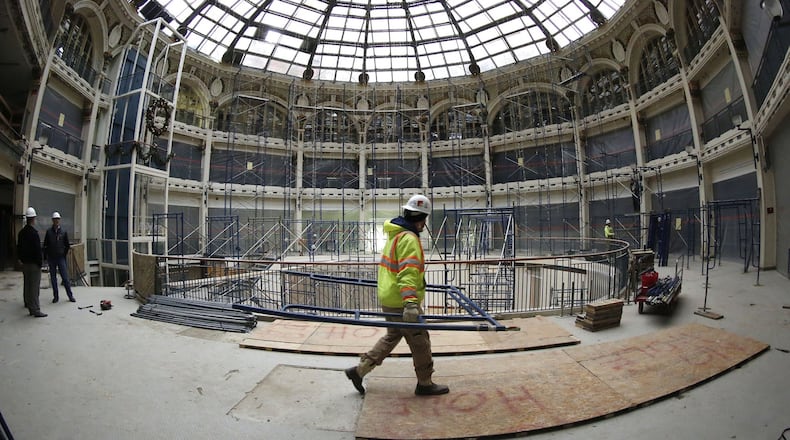Social media lit up with excitement this week when photos were posted online of demolition work going on inside the arcade’s iconic rotunda. Sparks flew as crews sawed apart an old escalator, and whirring drills echoed in the massive space as scaffolding was put up.
TRENDING: Partial government shutdown possible: Here’s what it means for Wright-Patt
Lots of people have talked about fixing up and re-opening the arcade over the years. But work finally is going on inside the arcade now, building permits have been applied for and bids have been sent out.
“The rubber is hitting the road now in terms of actual bids coming in for the work and putting all of that together,” said Trace Shaughnessy, vice president of McCormack Baron Salazar, which is developing the residential component of the project.
Earlier this year, the city of Dayton agreed to loan the group redeveloping the Dayton Arcade $10 million in support of the project.
TRENDING: GWOC shakeup: From 20 schools to 8
The development agreement allowed for an early release of up to $2 million of the funds for demolition work inside the complex. The development partners are Cross Street Partners, McCormack Baron Salazar and Model Group.
The early demolition money from the city is important to keep the project on schedule and to help contractors know more about building conditions, said David Williams, senior director of development for Cross Street Partners.
Crews this week erected scaffolding throughout the arcade rotunda. They cut apart and discarded the escalator to the lower level, which was installed around 1980.
The scaffolding that’s gone up will allow workers to remove old paint from the rotunda’s steel structure using a method called dry ice blasting, Williams said.
Plastic covering has been hung all around the rotunda for the remediation of lead paint. The rotunda was re-painted in about 1980 when it was converted from a marketplace to an urban mall, Williams said.
The rotunda will be the public space when the nine-building arcade complex is revitalized. The first floor will have about 16,000 square feet of event space.
TRENDING: School safety expert: Entrances can be made less vulnerable
Demolition will continue with the removal of the rotunda’s elevator, also installed around 1980. Railing on the first floor will be eliminated because the big hole in the middle of the floor will be filled in. Crews also are working on items like removing old pipe wrapping.
Construction fences are up on South Ludlow, blocking a lane of traffic, to provide a space for Dumpsters and a staging area.
Bid packages have been issued for about two-thirds of the work in the first phase of the project, Williams said, including plumbing, electrical, mechanical, fire protection, dry wall and flooring.
There’s still a lot more to do, Williams said, like finalizing tenant agreements and closing on the last building. The arcade development team acquired eight of the nine buildings earlier this year. The hope is to close financing for the $90 million first phase of the rehab project in January, Williams said.
McCormack Baron Salazar also recently finalized designs for the 110 apartments in the arcade to send out bids, Shaughnessy said, and it has requested building permits.
“We wouldn’t be doing that kind of stuff unless this was really moving forward,” Shaughnessy said.
Next year at this time, the glass dome should be redone, the exterior should be restored, the first floor should be in-filled and the storefronts should be finished, developers say.
Late spring of 2020 is when parts of the arcade are expected to re-open, they said.
About the Author

